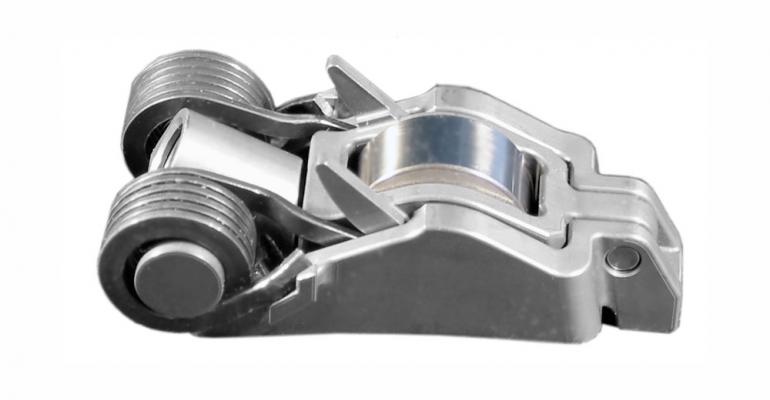Modern cylinder deactivation has been around for about a decade in pushrod V-8s from General Motors and Chrysler, and Honda has applied the fuel-saving technology to overhead-cam V-6s as well.
With today’s high-output turbocharged 4-cyl. engines capable of 300 hp, it’s conceivable many cars soon could ply American highways during light-load conditions drawing power from nothing but a pair of firing pistons, while the other two go along for the ride.
So if power densities continue climbing as expected and turbocharged 3-cyl. gasoline engines become as stout as some naturally aspirated 4-cyl. engines, then why not deactivate one of those three cylinders?
That’s a question powertrain technology supplier Schaeffler has been fielding from an increasing number of automaker customers seeking creative ways to jack up their CAFE ratings.
Engineers at Germany-based Schaeffler, which has delivered the switchable valve lifters enabling Chrysler and previous-generation GM cam-in-block V-8s to cut off air and fuel to half the cylinders, say they are helping customers develop three all-new 3-cyl. engines that will shut down one cylinder during certain conditions.
All the gasoline engines, intended for small cars, employ turbocharging and direct fuel injection.
If customer prototypes are available with these 3-cyl. engines using cylinder deactivation, David Kehr hasn’t driven them yet. Schaeffler’s manager of valvetrain systems is hoping to within six months.
Kehr says he is convinced there are certain conditions when a vehicle can get all the motivation it needs from two pistons pumping, thanks to recent advances in friction and weight reduction. It helps that automakers have been able to quell some of the unique noise and vibration challenges associated with 3-cyl. engines.
“It will make sense when the consumers don’t even know it’s there,” Kehr says of the technology. “To tell someone you’re going to do it, they’d probably have a lot of apprehension. But even with all the cylinder-deactivation applications that have hit the market, I would argue most people don’t even know it’s there.”
Chrysler was first to market 10 years ago this spring with its Multi-Displacement System on the Hemi V-8, narrowly ahead of GM’s Active Fuel Management technology on the small-block. Both automakers claim a fuel-economy gain of about 8%.
GM also used Schaeffler’s deactivation system on a 3.9L cam-in-block V-6 that appeared first in the Chevrolet Impala. But the system bowed out within a few years after its 2007 arrival because of modest fuel-economy gains.
With CAFE standards bearing down, a sense of urgency has forced automakers to consider options that seemed unthinkable not long ago.
Bob Zito, Schaeffler’s engineering director-engine components, says turbocharged direct-injection 3-cyl. engines soon will be capable of 180 hp. Ford’s 1.0L EcoBoost, a 2014 Ward’s 10 Best Engines winner, produces 123 hp.
A Sense of Urgency
Zito says automakers are considering cylinder deactivation in several future 4-, 6- and 8-cyl. engines, and there’s a good reason why 3-cyl. powerplants align nicely with the technology, as well.
Most OHC engines have four ports – two for intake and two for exhaust. Cylinder deactivation requires sophisticated hardware (a roller-finger follower to replace a typical lash adjuster) for each valve on whichever cylinder will be deactivated. That means idling two out of four cylinders is twice as expensive as idling one of three.
There’s a new approach known as “rolling” cylinder deactivation, which uses electronic controls to monitor driver behavior and pinpoint individual cylinders to shut off for specific times.
Schaeffler says the fuel-economy gain can be tremendous, but a lot of hardware is necessary on every cylinder, boosting cost.
Which explains the sudden interest in cylinder deactivation for 3-cyl. engines: It’s reasonably affordable.
Consider that 4-cyl. engines now dominate the U.S. market, and yet there are no I-4s using cylinder deactivation. Volkswagen has the 1.4L TSI in Europe that employs the technology, but it’s not available in the U.S.
Zito says it’s possible a 3-cyl. engine will come to market with cylinder deactivation before a larger 4-cyl. does.
OEMs Willing to Spend
Cost is everything for automakers, but the purse strings are loosening. The closer the CAFE deadlines approach (in 2017 and 2025), the more willing car manufacturers are to pay for the technology necessary to achieve compliance.
Zito says automakers no longer balk at an “on-cost” of up to $100 for each percentage gain in fuel economy derived by a particular new technology. That compares with $25 to $40 five years ago.
“As time has gone on, that low-hanging fruit where you are willing to pay $25 per percent, those elements are pretty much gone,” he says. “They’re already in production. We’ve already done all those things.”
Kehr says an I-3 with cylinder deactivation can consume at least 3% less fuel than the same engine without it, which could translate into a decent revenue stream for Schaeffler.
Zito says cylinder deactivation and variable valvetrain controls, such as the MultiAir system Schaeffler supplies to Fiat and Chrysler, have the advantage of being less expensive than tying in electric motors and batteries for a hybrid.
“It’s still cheaper to get more fuel economy out of the internal-combustion engine,” he says.
Electric vehicles have proved modern cars can get around without a single piston ever consuming a drop of gasoline.
But for the bulk of the vehicle market that still wants internal-combustion engines, the salient question remains: How low can cylinder counts go?




